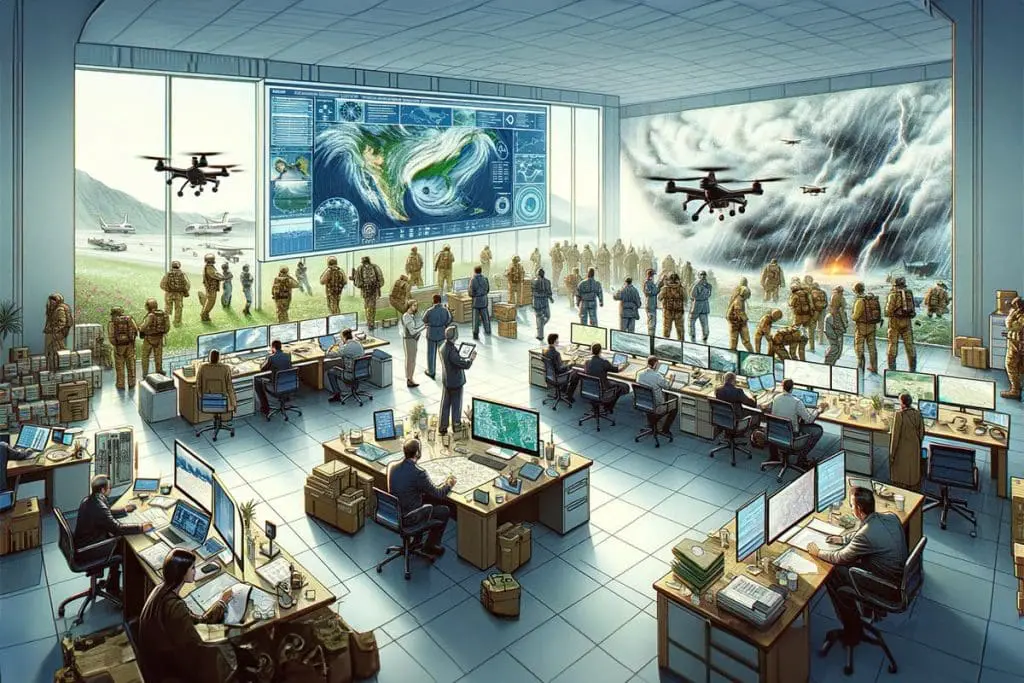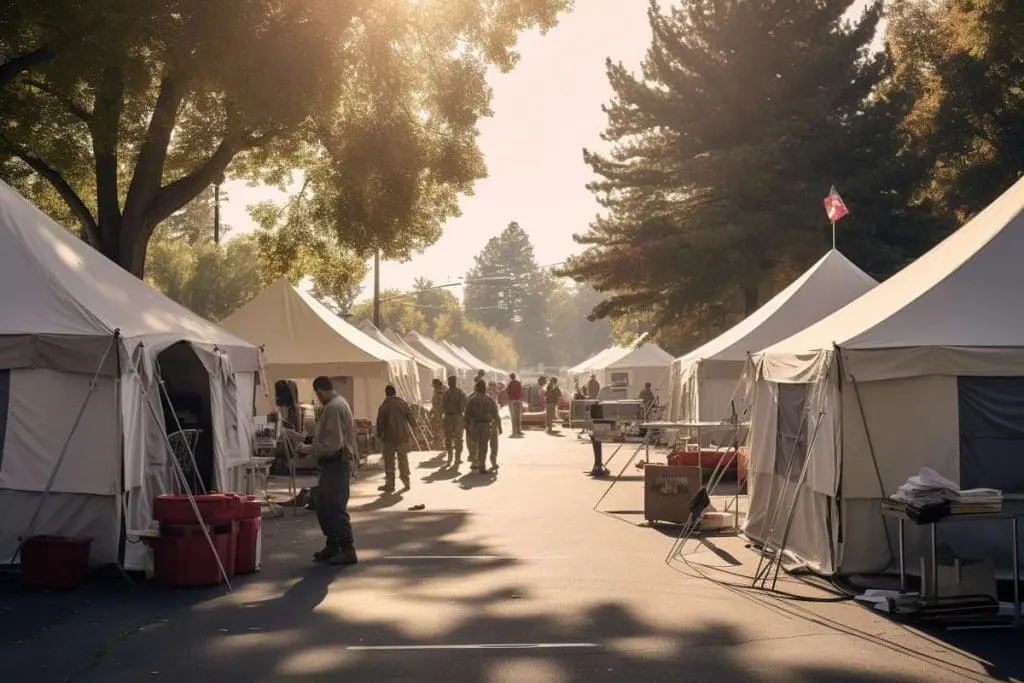The number and severity of natural disasters is rising. In 2022 alone, 387 natural disaster events were recorded, above the average of the previous 20 years.
Federal, state, and local governments play critical roles in preparing for, managing, and responding to natural disasters. Organizations like the Federal Emergency Management Agency (FEMA), local law enforcement agencies, and others are instrumental in ensuring that those who are impacted by a natural disaster—whether an earthquake, hurricane, tornado, wildfire, or other event—receive the aid they require to rebuild their lives and communities. They provide those who are impacted with shelter, food, medical assistance, financial guidance, and more.
In this blog, we look at what role the government plays during a natural disaster. We also examine the different agencies involved in disaster and emergency response and how they coordinate with each other to help communities reset and rebuild after a catastrophic event.
Table of Contents
Understanding the Government’s Role in Disaster Management

The government’s response to natural disasters begins long before the event occurs. Government agencies regularly prepare for adverse incidents to improve responsiveness and outcomes. During and after an event, teams respond quickly to provide immediate relief. They continue to help victims in the days, weeks, and months following the conclusion of the disaster by aiding in long-term recovery and reconstruction.
Preparedness and Prevention Strategies
Government preparedness for a natural disaster takes place 365 days a year. Federal, state, and local agencies continuously create and refine emergency response plans that include:
- Pre-disaster mitigation efforts, such as updating building codes; constructing disaster-resilient infrastructure that sustains high water levels, extreme heat, etc.; creating water retention areas in case of flooding; and more.
- Preparing government employees. This includes training government employees on how to respond to different scenarios, helping them understand their roles, and providing them with tools that will help them respond during an emergency (for example, Geographic Information Systems that show the location of hospitals, police and fire stations, and so forth).
Disaster preparedness and response do more than just save lives. According to the Pew Charitable Trust, every $1 spent on disaster mitigation saves government agencies $6 and creates jobs.
Immediate Response and Relief Efforts
Once a disaster strikes, government agencies put their plans into action and respond swiftly and surely. Emergency managers and first responders are sent to the scene to engage in search and rescue operations, provide immediate aid to victims, assess damage, and more. During this initial phase, the agencies in charge may also set up and manage shelters and provide victims with clothing, food, and water.
While first responders are helping the victims, other government agencies work hard to restore power and communications, provide transportation, and re-activate essential services. Meanwhile, law enforcement officials ensure public order and security.
Long-Term Recovery and Reconstruction
Recovery and reconstruction following a natural disaster can take months or even years. It’s a highly complex process that involves:
- Close collaboration between federal, state, and local governments.
- Continuous communication among recovery managers and other resources.
- Careful planning to ensure what is built in the aftermath is even more resilient than what came before.
- Paying close attention and attending to the needs of those who were displaced by the event.
Financial resources play a major role in recovery and reconstruction, both for individuals and communities. For example, FEMA provides financial assistance for both individuals and governments. The agency also offers grants that support critical recovery initiatives.
The Role of Local, State, and Federal Governments

Federal, state, and local governments each have unique and important roles to play in responding to disasters and supporting recovery efforts.
Local Government’s First Response
Local government agencies are the first line of defense when a natural disaster strikes. Local police, firefighters, emergency medical personnel, and others are quickly mobilized and dispatched to the scene, rushing to provide aid, coordinate rescue and recovery efforts, and ensure the safety and well-being of those who are impacted. These organizations collaborate with state and federal agencies to assist individuals and families in need, resulting in a well-coordinated and effective response.
In addition to first responders, public utility organizations work to restore electricity and heat, begin debris removal, and perform other tasks to help the community get back up and running.
State Government’s Coordination and Support
Often, disasters encompass more than just a single town, county, or tribal land, or are calamitous enough to warrant more assistance than local governments alone can provide. In such cases, municipalities may require the assistance of state governments to aid in response and recovery efforts.
Upon receiving a request for assistance, a state emergency management office will assess the request and advise the governor of specific actions to take. The governor may then declare a state of emergency and provide government resources to assist in the response and recovery process. For example, a state could assist in determining evacuation routes, controlling the flow of people into and out of the impacted area, suspend state laws and ordinances that could impede rescue efforts, and so on. The state may also request aid from neighboring states.
The state government is also a conduit for requesting assistance from the federal government. The governor may ask the president of the United States for a presidential disaster or emergency declaration, thereby authorizing federal assistance to the impacted area.
Federal Government and National Agencies
A presidential disaster or emergency declaration signals the federal government and national agencies to begin assisting in the affected areas.
First, FEMA prepares a document called the FEMA-State Agreement. Per FEMA, “this agreement describes the period of the incident (or disaster), the types of assistance to be provided, the areas eligible for assistance, the agreed-upon cost-share provisions, and other terms and conditions.”
Once the terms outlined in the document are agreed to by all parties, FEMA coordinates incident response. The agency uses its National Disaster Recovery Framework to coordinate the response, detailing the roles and responsibilities of the response team, managing lines of communication, and more.
On the ground, FEMA stands up a Disaster Field Office – essentially a headquarters where all recovery and response efforts are coordinated. Assistance rendered includes providing:
- Food to affected individuals and families.
- Housing assistance.
- Loans for individuals and businesses.
- Clothing, household items, vehicles, and other necessary needs.
Collaborative Efforts and Community Involvement

Effective disaster response and recovery requires close collaboration between government, local communities, and private companies. Here are some ways these partnerships help during times of crisis.
Role of Local Communities in Disaster Management
Local leaders and residents know their communities better than anyone else and are therefore critical to response and recovery. Indeed, there are many ways local communities can help with disaster management, including:
- Local residents and groups may volunteer to help coordinate response efforts, including donating and giving out supplies and providing input into decision-making to help prepare for future events.
- Residents with specific skill sets (physicians, engineers, contractors, etc.) can apply those skills to the recovery effort.
- Local leadership can provide strong and steady guidance to responders at the state and federal levels, and local volunteers, to expedite the operation.
Public-Private Partnerships in Disaster Response
Private sector organizations play an important part in disaster response. In addition to providing financial support and assistance, companies also offer resources and solutions that can help increase the efficiency and effectiveness of disaster response. Resources can include advanced technologies, equipment, and even employees, who will often donate their time to help in the response effort.
Conclusion: The Critical Role of Government in Disaster Management
All levels of government—local, state, and federal—play important roles in disaster management. Each level brings its own unique set of expertise and resources to recovery and response efforts. There are specific guidelines that must be followed before federal assistance is provided, but with that assistance comes substantial support that significantly augments the tireless efforts of local and state governments.
Finally, local communities and private sector organizations are also critical for an effective response. Residents and local leaders who know their communities well can provide important perspectives about what works best for their communities, as well as hands-on assistance. Private sector companies offer financial, technological, and human resources that can be invaluable as communities attempt to rebuild and recover.
Acuity International is ready to aid in disaster management and recovery efforts, wherever they are needed. Our disaster and emergency response services capabilities are aligned with FEMA’s national response framework and community lifelines. Through our organic resources and strategic partnerships, Acuity provides comprehensive, targeted response and logistics services that include on-site and mobile medical support, emergency influx shelters, and more. Our teams are always ready to respond to a crisis anywhere in the world within 48 hours.
Contact us to learn more about how Acuity International can assist in your disaster preparedness, recovery, and response.
